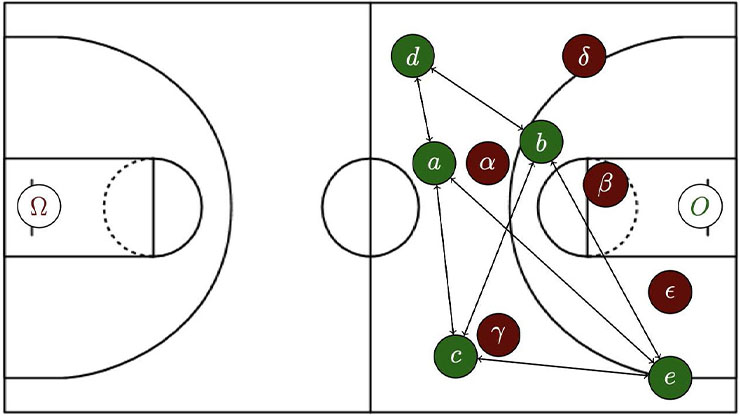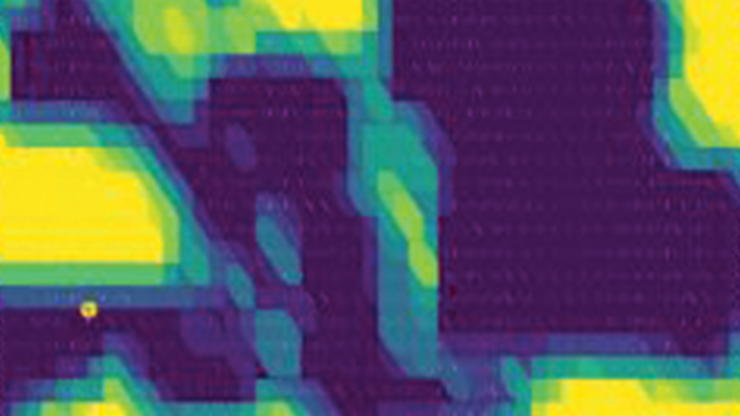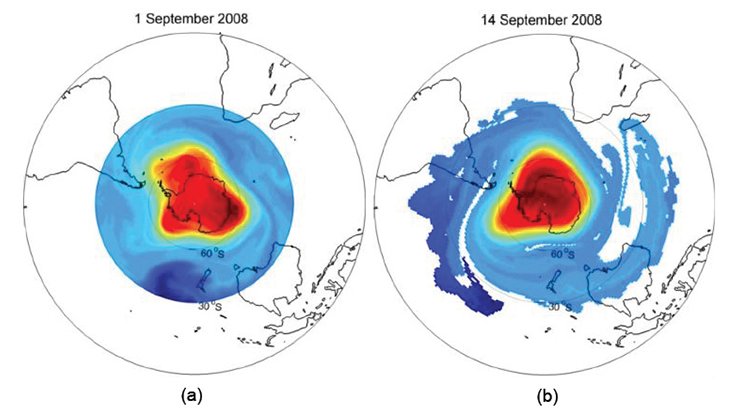Spectral Geometry for Dynamical Systems and Time-evolving Networks
Complex dynamics can display emergence, whereby simple (e.g., physics-based) microrules describe the interactions and evolutions of individual states. Collectively, however—and at the level of many states—complicated and observable macrophenomena may appear. We often characterize macrophenomena as large collections of individual states that evolve as a group for a substantial duration of time. For example, a sizeable cohort of individuals might hold a collective opinion for several years, or a mass of hot air parcels in the atmosphere may remain over a fixed geographic location and cause a heatwave.
Here, we show that the modification of classical ideas from spectral geometry can produce linear operators that are induced by nonlinear microdynamics whose leading eigenspectra and corresponding eigenfunctions highlight these macrophenomena, including their appearance and disappearance. We consider situations where the domain of microstates is a continuum (e.g., a manifold) and explore the same principles’ application to discrete domains — such as complex, time-evolving networks.
Spectral Geometry
Well-known connections exist between manifold geometry and the spectrum and eigenfunctions of the Laplace-Beltrami operator \(\Delta\) on \(M\) [2, 9]. By classical theory, the eigenproblem \(\Delta f=\lambda f\) on \(M\) with zero Neumann boundary conditions has countably many eigenvalues \(0=\lambda_1>\lambda_2>\cdots\) with eigenfunctions \(\{f_i\}_{i=1}^\infty\). Globally distant regions on \(M\) are encoded in the leading nontrivial eigenfunction \(f_2\) via extreme positive and negative values. For instance, the deep red and blue regions in Figure 1 are globally far away from one another.
![<strong>Figure 1.</strong> Laplace eigenfunctions \(f_2,\ldots,f_5\) of a two-dimensional manifold \(M\). Note that the deep red and deep blue regions of \(f_2\) (and by symmetry, \(f_3\)) are globally far from one another. Additional eigenfunctions \(f_4\), \(f_5\), etc. further decompose \(M\) according to geometric structure. Figure courtesy of [4].](/media/am1l2sfe/figure1.jpg)
The Dynamic Laplace Operator
We can generalize the above observations to a setting where the Riemannian manifold is subjected to general time-dependent dynamics. For such a generalization, the Laplace operator must also be extended to incorporate dynamics. We use \(\Phi^t:M\to \Phi^t(M)\) to denote a smooth transformation that describes the time-dependent evolution over time \(t\in[0,\tau]\); recall the natural pushforward operator \((\Phi^{t})_*f=f\circ (\Phi^{t})^{-1}\) and pullback operator \((\Phi^{t})^*f=f\circ \Phi^{t}\) on functions \(f:M\to\mathbb{R}\).
The dynamic extension of the classical Laplace operator is called the dynamic Laplacian \(\Delta^D\) on the time interval \([0,\tau]\) [3]. We define it as
\[{\Delta^D}:={\frac{1}{\tau}\int_{0}^{\tau} (\Phi^{t})^*\circ\Delta\circ(\Phi^{t})_*\ dt}={\frac{1}{\tau}\int_{0}^{\tau} \Delta_{g_t}\ dt},\]
where \(g_t=(\Phi^t)^*e\) is the pullback of the Euclidean metric \(e\). The local coordinate representation of \(g_t(x)\) is the matrix \(D\Phi^t(x)^\top D\Phi^t(x)\) — i.e., the Cauchy-Green tensor for the flow of length \(t\), initialized at \(x\). Therefore, \(\Delta^D\) is an average of Laplace-Beltrami operators for the Riemannian manifolds \(({M},g_t)\), \(t\in[0,T]\). The leading nontrivial eigenvalue \(\lambda_2^D\) of \(\Delta^D\) quantifies the global mixing that occurs over \([0,T]\), while the dynamic Laplace operator provides a dynamic spectral geometry on manifolds that are subjected to general time-dependent nonlinear dynamics.
Dynamic Laplacian Eigenfunctions
To illustrate the way in which eigenfunctions of the dynamic Laplacian identify coherent features, we use a flow [10] to evolve the unit square \(M=[0,1]^2\) with time-dependent nonlinear dynamics \(\Phi^t\), \(t\in[0,1]\). Figure 2a depicts the leading nontrivial eigenfunction \(f_2^D\) and highlights two elliptical regions: one red and one blue. Each of these regions is a coherent set, with future evolutions in Figure 2b and 2c. While the red and blue regions evolve, they do not mix; this is the essence of coherence.
![<strong>Figure 2.</strong> Evolution of two coherent sets in a highly nonlinear flow of the unit square. The deep red and deep blue colors indicate the two sets. <strong>2a.</strong> Leading nontrivial eigenfunction \(f_2^D
\) for the dynamic Laplacian. <strong>2b.</strong> Pushforward of \(f_2^D\) by \(1/2\) of a time unit to \(t=1/2\), namely \(f_2^D\circ(\Phi^{1/2})^{-1}\). <strong>2c.</strong> Pushforward of \(f_2^D\) by one time unit to \(t=1\), namely \(f_2^D\circ(\Phi^{1})^{-1}\). Figure courtesy of [4].](/media/aomhg2qi/figure2.jpg)
Identification of Distinct Macrostructures
![<strong>Figure 3.</strong> The application of sparse eigenbasis approximation (SEBA) to the leading eight eigenfunctions of the dynamic Laplacian in order to construct eight sparse SEBA vectors. Beginning in January 2011, each SEBA vector is supported in an individual coherent region of the deep ocean and remains coherent under ocean currents at a depth of 1,000 meters over a six-year duration (from 2011 to 2017). Figure courtesy of [1].](/media/tjpamn2p/figure3.jpg)
Multiple leading eigenfunctions of the dynamic Laplacian encode multiple coherent features, and spectral geometric theory utilizes additional eigenfunctions to underpin their use. Sometimes individual coherent features are not clearly represented in the eigenfunctions, necessitating a separation procedure. Sparse eigenbasis approximation (SEBA) [8] is a method that processes spectral clustering outputs to automatically disentangle distinct features; Figure 3 illustrates an example of SEBA in action. First, we use roughly 8,000 individual deep-sea Argo float trajectories to estimate the dynamic Laplacian; approximately 3,000 of these floats provide location signals in any given month [1]. In this dataset, only 10 percent of floats continue to transmit over the six years from 2011 to 2017. We then apply SEBA to the leading eight eigenfunctions of the dynamic Laplacian to separate the eight dominant coherent regions in the global ocean at a depth of 1,000 meters.
Emergence and Disappearance of Macrostructures
In many complex systems, multiple coexisting emergent features are ephemeral in that they emerge and exist for some time before dissipating. Through a time expansion of the domain, we can “inflate” the dynamic Laplacian to create a spectral theory that also captures this emergence and disappearance [6]. In the resulting time expansion of the phase space, each Riemannian manifold \((M,g_t)\) has its own \(t\)-fiber. Topologically, this time-expanded domain is simply
\[\mathbb{M}:=\bigcup_{t\in [0,T]}\{t\}\times M=[0,T]\times M.\]
The Inflated Dynamic Laplace Operator
To extend \(\Delta^D\) from an operator on \(M\) to an operator on \(\mathbb{M}_0\), we apply \(\Delta_{g_t}\) to the \(t\)th copy of \(M\)—i.e., to \(\{t\}\times M\subset \mathbb{M}\)—for each \(t=[0,T]\). We then employ diffusion in the temporal direction to dynamically connect the distinct \(t\)-fibers. In summary, we define a Laplace-Beltrami operator (the inflated dynamic Laplace operator) \(\Delta_{G_a}:L^2(\mathbb{M},G_a)\to L^2(\mathbb{M},G_a),\) where the metric \(G_a\) is Euclidean in the time direction and \(g_t\) on each \(t\)-fiber:
\[\Delta_{G_{a}} F(t,x) = a^2 \partial_{tt} F(\cdot,x)+ \Delta_{g_t} \, F(t,\cdot).\]
Researchers have used the associated spectral methodology to detect the breakup and reformation of atmospheric features, among other applications.
Emergent Structures in Complex Networks and Supra-Laplacians
In discrete settings, a graph or network replaces the manifold. Evolution on the network consists of temporal variation of edge weights, including their removal and insertion, as well as the addition or deletion of nodes. Instead of coherent sets, we search for time-evolving communities within the network where members of a single community are well connected by edges between community members; in contrast, members of distinct communities share relatively few connections. Scientists have utilized the dynamic Laplace matrix for graphs to spectrally study persistent time-varying communities [7].
![<strong>Figure 4.</strong> Quantification of political polarization in the U.S. Senate. <strong>4a.</strong> Leading nontrivial spatial eigenvector of a supra-Laplacian based on state voting similarities in the U.S. Senate. Deep red indicates strong membership in a Republican political bloc and deep blue indicates strong membership in a Democratic bloc. The evolution of membership in such groupings for each individual state is depicted horizontally. <strong>4b.</strong> The supra-Laplacian is built from the voting similarities of individual senators (two per state), which yield a larger eigenvector and more granular detail. A similar polarization in time is evident. Figure adapted from [5].](/media/ougco0ek/figure4.jpg)
Recent work [5] has adapted underlying theory and algorithms for the inflated dynamic Laplacian to supra-Laplacians on time-evolving graphs [11], leading to a greater theoretical understanding of these objects and the ability to detect changes via spectral methods in several communities over time. As a simple example, Figure 4a shows the leading nontrivial spacetime eigenvector of the supra-Laplacian [5] that was built from similarities [12] of U.S. state voting patterns from 1987 to 2023. The deeper colors in recent years indicate the increasing polarization of U.S. politics over the last four decades. Similar calculations are possible at the level of individual U.S. senators during the same time period, where senators continually enter and leave a state’s legislature (see Figure 4b). When mapped onto states, the leading nontrivial spacetime eigenvector of the supra-Laplacian for individual senators produces a more granular but consistent overall picture.
The advantages of spectral methods lie in their domain-global nature and computational accessibility. The aforementioned techniques—relevant to dynamics on both continuous and discrete domains—enable the application of spectral methods in time-varying dynamic settings and for the detection of multiple regime changes, such as the emergence of communities, coherent regions, and other macrostructures.
References
[1] Abernathey, R., Bladwell, C., Froyland, G., & Sakellariou, K. (2022). Deep Lagrangian connectivity in the global ocean inferred from Argo floats. J. Phys. Oceanogr., 52(5), 951-963.
[2] Cheeger, J. (1970). A lower bound for the smallest eigenvalue of the Laplacian. In R.C. Gunning (Ed.), Problems in analysis: A symposium in honor of Salomon Bochner (pp. 195-199). Princeton, NJ: Princeton University Press.
[3] Froyland, G. (2015). Dynamic isoperimetry and the geometry of Lagrangian coherent structures. Nonlinearity, 28(10), 3587-3622.
[4] Froyland, G. (2025). A tutorial on the dynamic Laplacian. In S. Oishi, H. Okamoto, & K. Hayami (Eds.), Recent developments in industrial and applied mathematics. ICIAM2023 Springer series. New York, NY: Springer. To appear.
[5] Froyland, G., Kalia, M., & Koltai, P. (2024). Multi-set spectral clustering of time-evolving networks using the supra-Laplacian. Preprint, arXiv:2409.11984.
[6] Froyland, G., & Koltai, P. (2023). Detecting the birth and death of finite-time coherent sets. Commun. Pure Appl. Math., 76(12), 3642-3684.
[7] Froyland, G., & Kwok, E. (2015). Partitions of networks that are robust to vertex permutation dynamics. Spec. Matrices, 3(1), 22-42.
[8] Froyland, G., Rock, C.P., & Sakellariou, K. (2019). Sparse eigenbasis approximation: Multiple feature extraction across spatiotemporal scales with application to coherent set identification. Commun. Nonlinear Sci. Numer. Sim., 77(8), 81-107.
[9] Grebenkov, D.S., & Nguyen, B.-T. (2013). Geometrical structure of Laplacian eigenfunctions. SIAM Rev., 55(4), 601-667.
[10] Mosovsky, B.A., & Meiss, J.D. (2011). Transport in transitory dynamical systems. SIAM J. Appl. Dyn. Syst., 10(1), 35-65.
[11] Solé-Ribalta, A., De Domenico, M., Kouvaris, N.E., Díaz-Guilera, A., Gómez, S., & Arenas, A. (2013). Spectral properties of the Laplacian of multiplex networks. Phys. Rev. E, 88(3), 032807.
[12] Waugh, A.S., Pei, L., Fowler, J.H., Mucha, P.J., & Porter, M.A. (2009). Party polarization in Congress: A network science approach. Preprint, arXiv:0907.3509.
About the Author
Gary Froyland
Scientia Professor, University of New South Wales
Gary Froyland is a Scientia Professor in the School of Mathematics and Statistics at the University of New South Wales in Sydney, Australia.
Related Reading
Stay Up-to-Date with Email Alerts
Sign up for our monthly newsletter and emails about other topics of your choosing.






